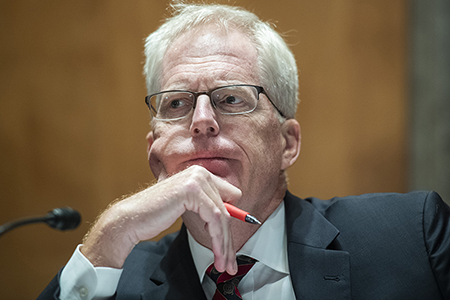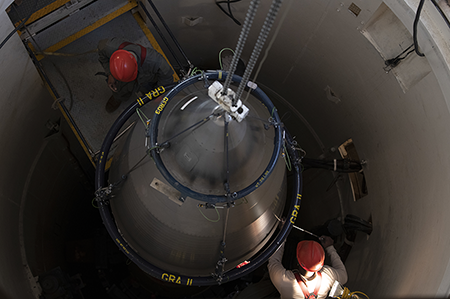"In my home there are few publications that we actually get hard copies of, but [Arms Control Today] is one and it's the only one my husband and I fight over who gets to read it first."
Trump, the United States, and the New Nuclear Arms Race
December 2024
By Geoff Wilson
The world is on the brink of a frightening new nuclear age. Over the past decade, all nine of the world’s nuclear-armed states have committed to a path of expansive new nuclear weapons spending and modernization. Many of these nuclear programs have grown to include not only upgrading and retrofitting extant nuclear weapons systems, but also the development of entirely new weapons including many described as “exotic,” “battlefield,” or “nonstrategic.” Many experts say this trend is a worrisome departure from traditional “deterrence-based” approaches and may herald a return to a more coercive Cold War-like role for the world’s nuclear arsenals.

The United States has led the charge in this new nuclear arms race, dedicating $1.7 trillion to its nuclear arsenal over the next 30 years, or roughly $75 billion a year between fiscal years 2023 and 2032, according to the nonpartisan Congressional Budget Office. To put that figure into context, adjusted for inflation to 2023 dollars, the four years of the Manhattan Project cost approximately $30 billion, while all eight years of President Ronald Reagan’s nuclear buildup cost about $75 billion.1 That means that Washington currently is spending twice as much a year on nuclear weapons as it did during all four years of the nuclear weapons development during World War II and the same amount as during all eight years of the last major nuclear spending drive of the Cold War.
This spending spree is underwriting a transformational effort to replace simultaneously all three legs of the U.S. nuclear triad—the land-based missiles, strategic bombers, and stealthy nuclear submarines that carry most of the 1,670 U.S. deployed strategic nuclear warheads. It has opened the door to development of the first entirely new nuclear warheads and plutonium weapons cores that the United States has built since the 1980s and ultimately may force the state to consider resuming nuclear testing for the first time since 1992. Unfortunately for U.S. taxpayers, most of these expensive programs are significantly behind schedule and overbudget.2
Donald Trump’s election to a second presidential term is likely to stoke this new nuclear arms race even further. During his first term, President Trump’s agenda was a paradigm shift from how nearly all his predecessors acted in regard to the U.S. nuclear arsenal. The way Trump talked about nuclear weapons, supposedly asking at one point “if we have these weapons, why can’t I use them” and threatening North Korea with “fire and fury like the world has ever seen,” shocked many people.3 The development of new and more usable nonstrategic nuclear weapons such as the W76-2 warhead, which is deployed on Navy submarines, and the nuclear-armed submarine-launched cruise missile, which is still under development, signaled that the United States might turn away from Reagan’s declaration that “a nuclear war cannot be won and must never be fought” and instead could see a use for a “limited” nuclear strike and war-fighting strategy.
As a result, there is real cause for concern that the United States will continue to commit itself to an expanded role for nuclear weapons in its military and foreign policy. Congressional leaders, military commanders, and former Trump administration officials are campaigning for new nuclear weapons and funding above the current $1.7 trillion nuclear modernization program. Nuclear spending boosters point to the recent findings of the Congressional Commission on the Strategic Posture of the United States, which among other escalatory steps suggested that the government consider developing new road-mobile intercontinental ballistic missiles (ICBMs) and new tactical nuclear forces to be deployed in the Indo-Pacific and European theaters.4
Senator Deb Fischer (R-Neb.), for one, argued that the report showed that the massive $1.7 trillion program of record was “essential, although not sufficient” to maintain U.S. national security in the near future.5 Pointedly, when questioned at a Senate Armed Services Committee hearing about what these additional changes to U.S. nuclear forces would cost and how the country would pay for them, a commission spokesperson said that the panel deliberately avoided that issue when the report was written.6
Political posturing during the 2024 campaign pushed calls for more spending even further. For instance, Trump’s former acting defense secretary, Christopher Miller, wrote as part of Project 2025, the putative policy playbook for a second Trump term, that a new administration should develop a nuclear arsenal “with the size, sophistication, and tailoring, including new capabilities at the theater level, to ensure that there is no circumstance in which America is exposed to serious nuclear coercion.” In addition, he proposed to restore readiness to test nuclear weapons, reject congressional proposals that would further extend the service lives of U.S. capabilities such as the Minuteman III ICBM in favor of buying new systems, and improve the U.S. ability to use the triad’s upload capacity in case of a crisis, thus enabling the rearming of U.S. missiles with more warheads than currently allowed under treaty limits.7
Robert O’Brien, one of Trump’s former national security advisers, echoed several of these points when he wrote that the United States must develop nuclear weapons platforms more quickly, purchase more new platforms, and test new nuclear weapons “in the real world for the first time since 1992, not just by using computer models.”8
If the administration follows these proposals, there could be a quick move within its first year to reactivate dormant missile silos and rearm U.S. ICBMs with multiple nuclear warheads. Similarly, there could be significant new funding for nuclear weapons systems and preparations for new explosive nuclear testing because Trump’s Republican Party controls both houses of Congress.9

Despite such trends, there is some hope for restraint. The existing nuclear weapons program is already a serious drain on the defense budget. Marquee triad replacement initiatives—the Sentinel ICBM, the Columbia-class ballistic missile submarine, and the B-21 strategic bomber—are all significantly behind schedule and overbudget. As a self-styled canny businessman, Trump could be well served by canceling or reducing programs that clearly are failing.
The Sentinel missile offers the clearest opportunity, having had its budget balloon by more than 80 percent. The missile promises to get more expensive as the Air Force and prime contractor Northrup Grumman face unexpected technical hurdles and the dubious prospect of having to reopen the contract to bidding for new parts.10 Moreover, as the national security focus turns more toward China, U.S. land-based ICBMs can only be targeted effectively against Russia. That is because these ballistic missiles would have to overfly Russia to reach China, likely buying any U.S. president two nuclear wars for the price of one.
Barring significant course corrections, the world should expect Trump to lead an expanding U.S. commitment to the global nuclear arms race. During his first term, Trump broke with nearly 50 years of history by becoming the first U.S. president since Richard Nixon not to negotiate an arms control treaty. That seems unlikely to change given Project 2025’s calls for the administration to outright reject any new treaty that might limit the deployment of U.S. nuclear forces. Paired with growing calls from political forces for the United States to seek technical and numerical superiority in its nuclear arsenal, the prospect of an unconstrained nuclear arms race could pose a real threat.
Facing such a future, experts and advocates concerned with reducing nuclear dangers should remind U.S. leaders that merely possessing more nuclear weapons during the Cold War did little to make the nation safer. Quite the contrary, the unintended accidents, miscalculations, and miscomprehensions caused by seeking nuclear supremacy nearly led to global Armageddon on more than one occasion.
The truth is that the world almost did not survive the last nuclear arms race. U.S. political leaders and military experts should not risk repeating those mistakes by insisting that the only way to ensure national security is to possess more nuclear weapons or introduce more novel and destabilizing nuclear weapons in the hopes of achieving some ultimately unquantifiable supremacy over nuclear rivals.
ENDNOTES
1. U.S. National Park Service, “Manhattan Project: Frequently Asked Questions,” July 19, 2024, https://www.nps.gov/mapr/faqs.htm#:~:text=The%20Manhattan%20Project%20cost%20approximately,War%20Powers%20Act%20of%201941; Daryl Kimball, “Looking Back: The Nuclear Arms Control Legacy of Ronald Reagan,” Arms Control Today, July 2004, https://www.armscontrol.org/act/2004-07/arms-control-today/looking-back-nuclear-arms-control-legacy-ronald-reagan. These figures have been updated to 2023 constant dollars.
2. Geoff Wilson, “America’s Nuclear Weapons Quagmire,” Stimson Center, August 7, 2024, https://www.stimson.org/2024/americas-nuclear-weapons-quagmire/.
3. Mattew J. Belvedere, “Trump Asks Why U.S. Can’t Use Nukes: MSNBC,” CNBC, August 3, 2016, https://www.cnbc.com/2016/08/03/trump-asks-why-us-cant-use-nukes-msnbcs-joe-scarborough-reports.html; Peter Baker and Choe Sang-Hun, “Trump Threatens ‘Fire and Fury’ Against North Korea If It Endangers U.S.,” The New York Times, August 8, 2017.
4. Congressional Commission on the Strategic Posture of the United States, “America’s Strategic Posture,” October 2023, https://armedservices.house.gov/sites/republicans.armedservices.house.gov/files/Strategic-Posture
-Committee-Report-Final.pdf.
5. Office of Senator Deb Fischer, “Fischer: Biden’s Defense Budget Proposal Fails to Address Rising Threats From China and Russia,” April 9, 2024, https://www.fischer.senate.gov/public/index.cfm/2024/4/fischer-biden-s-defense-budget-proposal-fails-to-address-rising-threats-from-china-and-russia.
6. U.S. Senate Committee on Armed Services, “Open/Closed: To Receive Testimony on the Findings of the Congressional Commission on the Strategic Posture of the United States,” October 19, 2023, 54:20-57:00, https://www.armed-services.senate.gov/hearings/to-receive-testimony-on-the-findings-of-the-congressional-commission-on-the-strategic-posture-of-the-united-states.
7. Christopher Miller, “Department of Defense,” in Mandate for Leadership: The Conservative Promise, ed. Paul Dans and Steven Groves, 2023, pp. 95-125.
8. Robert O’Brien, “The Return of Peace Through Strength,” Foreign Affairs, July/August 2024, https://www.foreignaffairs.com/united-states/return-peace-strength-trump-obrien.
9. Office of Senator Roger Wicker, “Senator Wicker Joins National Security Shows to Discuss ‘Peace Through Strength’ Plan,” August 27, 2024, https://www.wicker.senate.gov/2024/8/senator-wicker-joins-national-security-shows-to-discuss-peace-through-strength-plan.
10. Doug Cameron, “U.S. Nuclear Missile Silos Need Modernizing, but Fixes Aren’t Coming Soon,” The Wall Street Journal, August 26, 2024.
Geoff Wilson is a distinguished fellow and senior adviser at the Stimson Center.
